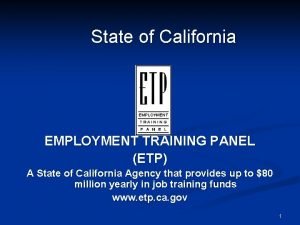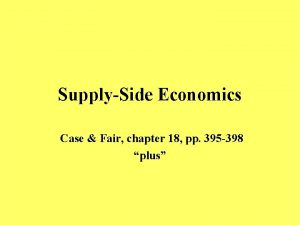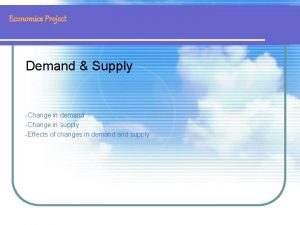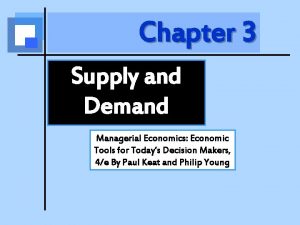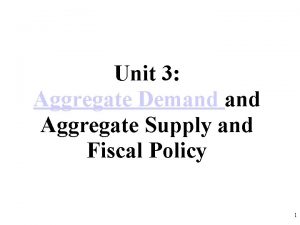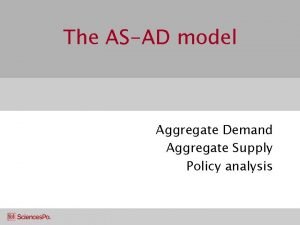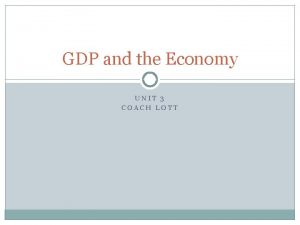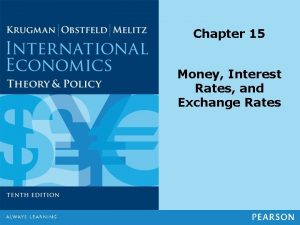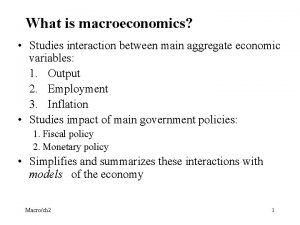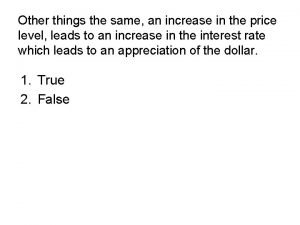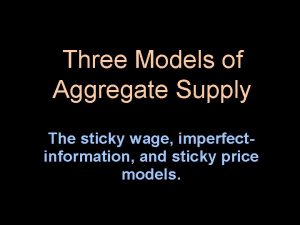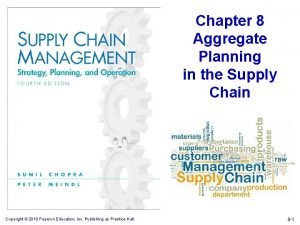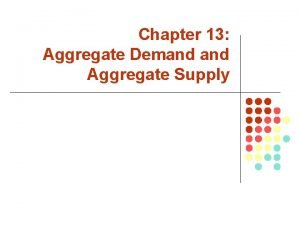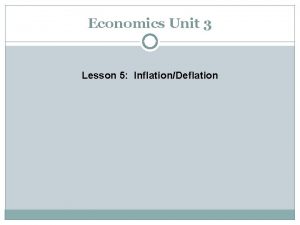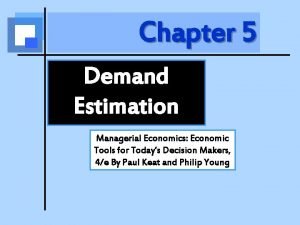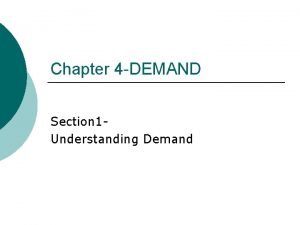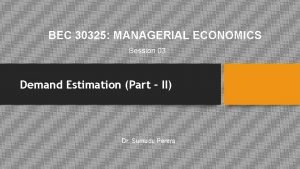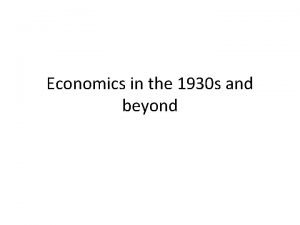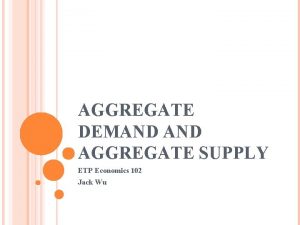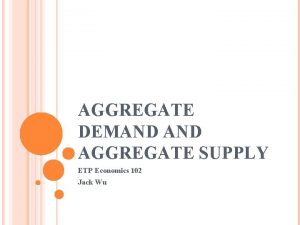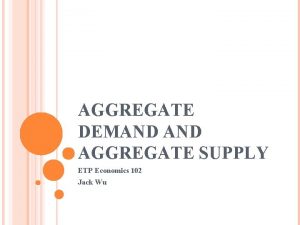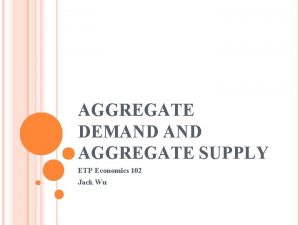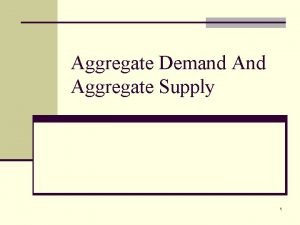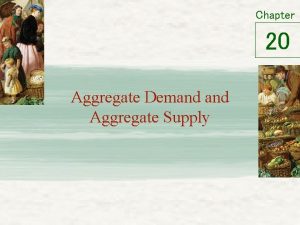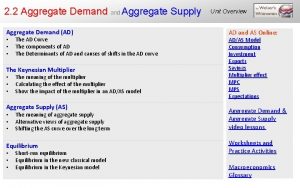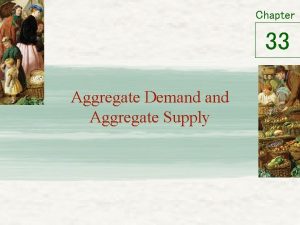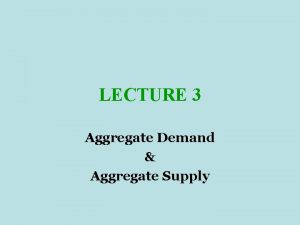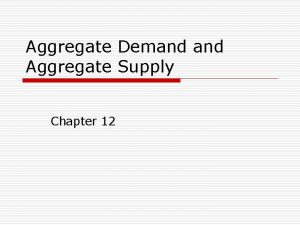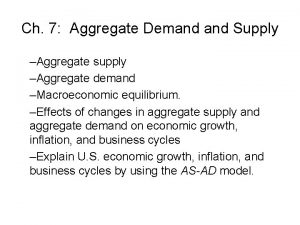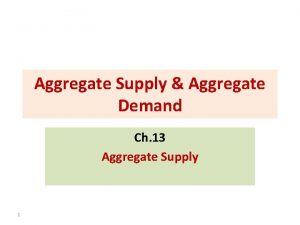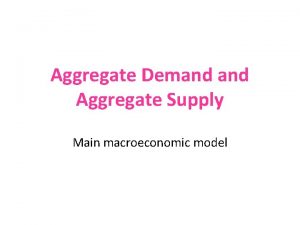Aggregate Demand Aggregate Supply ETP Economics 102 Jack












































- Slides: 44

Aggregate Demand Aggregate Supply ETP Economics 102 Jack Wu

Short-Run Economic Fluctuation Economic activity fluctuates from year to year. A recession is a period of declining real incomes, and rising unemployment. A depression is a severe recession.

Key Fact 1 Economic fluctuations are irregular and unpredictable. Fluctuations in the economy are often called the business cycle.

Key Fact 2 Most macroeconomic variables fluctuate together. Most macroeconomic variables that measure some type of income or production fluctuate closely together. Although many macroeconomic variables fluctuate together, they fluctuate by different amounts.

Key Fact 3 As output falls, unemployment rises. Changes in real GDP are inversely related to changes in the unemployment rate. During times of recession, unemployment rises substantially.

Explaining Short-Run Fluctuation How the Short Run Differs from the Long Run Most economists believe that classical theory describes the world in the long run but not in the short run. Changes in the money supply affect nominal variables but not real variables in the long run. The assumption of monetary neutrality is not appropriate when studying year-to-year changes in the economy.

Basic Model Two variables are used to develop a model to analyze the short-run fluctuations. The economy’s output of goods and services measured by real GDP. The overall price level measured by the CPI or the GDP deflator. The Basic Model of Aggregate Demand Aggregate Supply Economist use the model of aggregate demand aggregate supply to explain short-run fluctuations in economic activity around its long-run trend.

Aggregate Demand Supply Curves The aggregate-demand curve shows the quantity of goods and services that households, firms, and the government want to buy at each price level. The aggregate-supply curve shows the quantity of goods and services that firms choose to produce and sell at each price level.

Aggregate Demand Aggregate Supply Price Level Aggregate supply Equilibrium price level Aggregate demand 0 Equilibrium output Quantity of Output Copyright © 2004 South-Western

Aggregate Demand Curve The four components of GDP (Y) contribute to the aggregate demand for goods and services. Y = C + I + G + NX

The Aggregate-Demand Curve. . . Price Level P P 2 1. A decrease in the price level. . . 0 Aggregate demand Y Y 2 Quantity of Output 2. . increases the quantity of goods and services demanded. Copyright © 2004 South-Western

Three Effects The Price Level and Consumption: The Wealth Effect The Price Level and Investment: The Interest Rate Effect The Price Level and Net Exports: The Exchange-Rate Effect

Wealth Effect The Price Level and Consumption: The Wealth Effect A decrease in the price level makes consumers feel more wealthy, which in turn encourages them to spend more. This increase in consumer spending means larger quantities of goods and services demanded.

Interest Rate Effect The Price Level and Investment: The Interest Rate Effect A lower price level reduces the interest rate, which encourages greater spending on investment goods. This increase in investment spending means a larger quantity of goods and services demanded.

Exchange Rate Effect The Price Level and Net Exports: The Exchange-Rate Effect When a fall in the U. S. price level causes U. S. interest rates to fall, the real exchange rate depreciates, which stimulates U. S. net exports. The increase in net export spending means a larger quantity of goods and services demanded.

Move Along or Shift the Curve The downward slope of the aggregate demand curve shows that a fall in the price level raises the overall quantity of goods and services demanded. Many other factors, however, affect the quantity of goods and services demanded at any given price level. When one of these other factors changes, the aggregate demand curve shifts.

Shifts arising from Consumption Investment Government Purchases Net Exports

Demand Curve Shifts Price Level P 1 D 2 Aggregate demand, D 1 0 Y 1 Y 2 Quantity of Output

Aggregate Supply Curve In the long run, the aggregate-supply curve is vertical. In the short run, the aggregate-supply curve is upward sloping.

Long-Run Aggregate Supply Curve The Long-Run Aggregate-Supply Curve In the long run, an economy’s production of goods and services depends on its supplies of labor, capital, and natural resources and on the available technology used to turn these factors of production into goods and services. The price level does not affect these variables in the long run.

The Long-Run Aggregate-Supply Curve Price Level Long-run aggregate supply P P 2 2. . does not affect the quantity of goods and services supplied in the long run. 1. A change in the price level. . . 0 Natural rate of output Quantity of Output Copyright © 2004 South-Western

Long-Run Aggregate Supply Curve The Long-Run Aggregate-Supply Curve The long-run aggregate-supply curve is vertical at the natural rate of output. This level of production is also referred to as potential output or full-employment output. Any change in the economy that alters the natural rate of output shifts the long-run aggregate-supply curve. The shifts may be categorized according to the various factors in the classical model that affect output.

Shifts arising Labor Capital Natural Resources Technological Knowledge

Long-Run Growth and Inflation 2. . and growth in the money supply shifts aggregate demand. . . Long-run aggregate supply, LRAS 1980 LRAS 1990 LRAS 2000 Price Level 1. In the long run, technological progress shifts long-run aggregate supply. . . P 2000 4. . and ongoing inflation. P 1990 Aggregate Demand, AD 2000 P 1980 AD 1990 AD 1980 0 Y 1980 Y 1990 Quantity of Output 3. . leading to growth in output. . . Y 2000 Copyright © 2004 South-Western

Short-Run Aggregate Supply Curve Short-run fluctuations in output and price level should be viewed as deviations from the continuing long-run trends. In the short run, an increase in the overall level of prices in the economy tends to raise the quantity of goods and services supplied. A decrease in the level of prices tends to reduce the quantity of goods and services supplied.

The Short-Run Aggregate-Supply Curve Price Level Short-run aggregate supply P P 2 2. . reduces the quantity of goods and services supplied in the short run. 1. A decrease in the price level. . . 0 Y 2 Y Quantity of Output Copyright © 2004 South-Western

Three Theories The Misperceptions Theory The Sticky-Wage Theory The Sticky-Price Theory

Misperception Theory The Misperceptions Theory Changes in the overall price level temporarily mislead suppliers about what is happening in the markets in which they sell their output: A lower price level causes misperceptions about relative prices. These misperceptions induce suppliers to decrease the quantity of goods and services supplied.

Sticky-Wage Theory The Sticky-Wage Theory Nominal wages are slow to adjust, or are “sticky” in the short run: Wages do not adjust immediately to a fall in the price level. A lower price level makes employment and production less profitable. This induces firms to reduce the quantity of goods and services supplied.

Sticky-Price Theory Prices of some goods and services adjust sluggishly in response to changing economic conditions: An unexpected fall in the price level leaves some firms with higher-than-desired prices. This depresses sales, which induces firms to reduce the quantity of goods and services they produce.

The Long-Run Equilibrium Price Level Long-run aggregate supply Short-run aggregate supply A Equilibrium price Aggregate demand 0 Natural rate of output Quantity of Output Copyright © 2004 South-Western

Two Causes of Economic Fluctuation Shifts in Aggregate Demand In the short run, shifts in aggregate demand cause fluctuations in the economy’s output of goods and services. In the long run, shifts in aggregate demand affect the overall price level but do not affect output. An Adverse Shift in Aggregate Supply A decrease in one of the determinants of aggregate supply shifts the curve to the left: Output falls below the natural rate of employment. Unemployment rises. The price level rises

A Contraction in Aggregate Demand 2. . causes output to fall in the short run. . . Price Level Long-run aggregate supply Short-run aggregate supply, AS AS 2 3. . but over time, the short-run aggregate-supply curve shifts. . . A P B P 2 P 3 1. A decrease in aggregate demand. . . C Aggregate demand, AD AD 2 0 Y 2 Y 4. . and output returns to its natural rate. Quantity of Output Copyright © 2004 South-Western

An Adverse Shift in Aggregate Supply 1. An adverse shift in the shortrun aggregate-supply curve. . . Price Level Long-run aggregate supply AS 2 Short-run aggregate supply, AS B P 2 A P 3. . and the price level to rise. Aggregate demand 0 Y 2 2. . causes output to fall. . . Y Quantity of Output Copyright © 2004 South-Western

Stagflation Adverse shifts in aggregate supply cause stagflation—a period of recession and inflation. Output falls and prices rise. Policymakers who can influence aggregate demand cannot offset both of these adverse effects simultaneously.

Policy Responses to Recession Policymakers may respond to a recession in one of the following ways: Do nothing and wait for prices and wages to adjust. Take action to increase aggregate demand by using monetary and fiscal policy.

Accommodating an Adverse Shift in Aggregate Supply 1. When short-run aggregate supply falls. . . Price Level Long-run aggregate supply P 3 C P 2 3. . which P causes the price level to rise further. . . 0 A 4. . but keeps output at its natural rate. Natural rate of output Short-run aggregate supply, AS AS 2 2. . policymakers can accommodate the shift by expanding aggregate demand. . . AD 2 Aggregate demand, AD Quantity of Output Copyright © 2004 South-Western

An economic contraction caused by a shift in aggregate demand causes prices to a. rise in the short run, and rise even more in the long run. b. rise in the short run, and fall back to their original level in the long run. c. fall in the short run, and fall even more in the long run. d. fall in the short run, and rise back to their original level in the long run.

Suppose the U. S. economy is in long-run equilibrium. Then suppose the value of the U. S. dollar increases. At the same time, people in the U. S. revise their expectations so that the expected price level falls. We would expect that in the short-run a. real GDP will rise and the price level might rise, fall, or stay the same. b. real GDP will fall and the price level might rise, fall, or stay the same. c. the price level will rise, and real GDP might rise, fall, or stay the same. d. the price level will fall, and real GDP might rise, fall, or stay the same.

According to the aggregate demand aggregate supply model, in the long run an increase in the money supply leads to a. increases in both the price level and real GDP. b. an increase in real GDP but does not change the price level. c. an increase in the price level but does not change real GDP. d. does not change either the price level or real GDP.

The economy is in long-run equilibrium. Suppose that automatic teller machines become cheaper and more convenient to use, and as a result the demand for money falls. Other things equal, we would expect that in the short run, a. the price level and real GDP would rise, but in the long run they would both be unaffected. b. the price level and real GDP would rise, but in the long run the price level would rise and real GDP would be unaffected. c. the price level and real GDP would fall, but in the long run they would both be unaffected. d. the price level and real GDP would fall, but in the long run the price level would fall and real GDP would be unaffected.

Assume that the MPC is 0. 75. Assuming only the multiplier effect matters, an increase in government purchases of $200 billion will shift the aggregate demand curve a. left by $150 billion. b. left by $200 billion. c. right by $800 billion. d. None of the above are correct.

If Congress cuts spending to balance the federal budget, the Fed can act to prevent unemployment and recession while maintaining the balanced budget by a. increasing the money supply. b. decreasing the money supply. c. raising taxes. d. cutting expenditures.

Which of the following policies would Keynes’ followers support when an increase in business optimism shifts the aggregate demand curve to the right away from long-run equilibrium? a. decrease taxes b. increase government expenditures c. increase the money supply d. None of the above is correct.
 Sras lras
Sras lras Ad curve graph
Ad curve graph Unit 3 aggregate demand and aggregate supply
Unit 3 aggregate demand and aggregate supply Tax multiplier formula
Tax multiplier formula Unit 3 aggregate demand aggregate supply and fiscal policy
Unit 3 aggregate demand aggregate supply and fiscal policy Aggregate of chapter 6
Aggregate of chapter 6 Aggregate of chapter 6
Aggregate of chapter 6 Aggregate demand supply graph
Aggregate demand supply graph Planning techniques
Planning techniques Etp presentation
Etp presentation Etp pharmacy
Etp pharmacy California etp program
California etp program Supply side economics vs keynesian
Supply side economics vs keynesian Supply and demand economics project
Supply and demand economics project Supply and demand economics project
Supply and demand economics project Demand and supply in managerial economics
Demand and supply in managerial economics Module 5 supply and demand introduction and demand
Module 5 supply and demand introduction and demand Matching supply with demand
Matching supply with demand Main characters in jack and the beanstalk
Main characters in jack and the beanstalk Cannot mix aggregate and non aggregate tableau
Cannot mix aggregate and non aggregate tableau Why is aggregate demand downward sloping
Why is aggregate demand downward sloping Sras lras
Sras lras Real interest rate formula economics
Real interest rate formula economics Aggregate demand curve
Aggregate demand curve Recessionary gap aggregate demand
Recessionary gap aggregate demand The aggregate real money demand schedule l(r,y)
The aggregate real money demand schedule l(r,y) The aggregate real money demand schedule l(r,y)
The aggregate real money demand schedule l(r,y) Short run effects of expansionary monetary policy
Short run effects of expansionary monetary policy What is nominal gdp
What is nominal gdp Aggregate demand diagram
Aggregate demand diagram Which of the following shifts aggregate demand to the left?
Which of the following shifts aggregate demand to the left? What is sticky wage model
What is sticky wage model Aggregate planning in supply chain
Aggregate planning in supply chain The aggregate supply curve is
The aggregate supply curve is Aggregate supply shifters
Aggregate supply shifters Aggregate supply curve
Aggregate supply curve Which aggregate supply curve has a positive slope
Which aggregate supply curve has a positive slope Maastricht university economics and business economics
Maastricht university economics and business economics Mathematical vs non mathematical economics
Mathematical vs non mathematical economics Demand estimation in managerial economics
Demand estimation in managerial economics Lesson 5: inflation
Lesson 5: inflation What is demand estimation in managerial economics
What is demand estimation in managerial economics Economics chapter 4 section 1 understanding demand answers
Economics chapter 4 section 1 understanding demand answers Demand estimation in managerial economics
Demand estimation in managerial economics Supply side economics
Supply side economics











